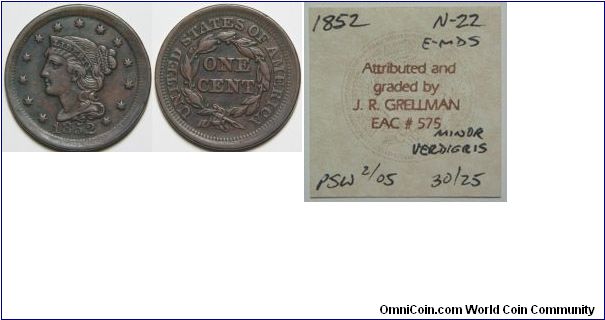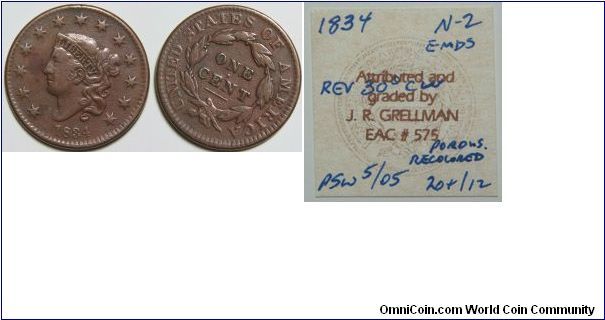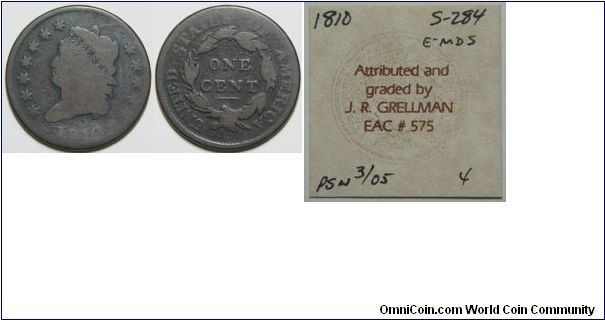-
Posts
56,652 -
Joined
-
Last visited
Content Type
Profiles
Forums
Gallery
Events
Articles
Posts posted by Art
-
-
It appears to be an excellent program and probably draws a lot of kids into collecting. Wish they had photos.

-
In my thinking anything 20th Century and beyond is modern, regardless of the materials or manufacturing processes used.

-
That's a great coin and a terrific writeup. I'm sure it was a much appreciated gift.

-
I have the Snorters all packaged up and ready to go in the mail tomorrow.
Fantastic. That means that by mid/end week I should have them out in the mail to their rightful owners.

-
Damn Art, I was bidding on some of his stuff.
 Score anything else?
Score anything else?Actually I scored all three Large Cents that he had up. I didn't even look at the bids or bidders. Set my snipes yesterday and just checked in today to make sure that I had ample "wiggle room". Sorry, hope I didn't hurt you too bad on this stuff.

-
1852N22 E-MDS 
-
1834N2 E-MDS w/ Rotated Reverse 30CW 
-
Just won these guys on eBay. They're from a gentleman who's an EAC member and each Large Cent was attributed and graded by Grellman.
1810 S-284 
-
Hm, ok. But we still get to use our own notes for the 2005 Short Snorters right?
You absolutely will use your own notes for the ShortSnorters. The Snorts will be a single set of notes that we'll then use for some special purposes here at CoinPeople. They'll be 1, 5, 10, 20, 50, and 100 Snorts. The idea is to make them something special.
I want to get a Ghana note for my ShortSnorter2005. I've got a terrific 5£ note that I was thinking of using but I'd rather go with the Ghana note.

-
Grellman is an excellent reference ... I use it exclusively to attribute the late dates.
I'm still struggling with the DRN but I'll get it eventually - I hope.

-
I think the notes are wonderful and I'd like to thank Ætheling for all of his hard work in creating them. When we start the 2005 Short Snorters on their rounds, I'll include a custom printed set of Snorts. Each person will be asked to sign the Snorts along with the other notes. When the project is completed, the Snorts will be used for special needs such as being auctioned off to provide funds for a CoinPerson in need. You get the idea.
So there will be only one official set of Snorts 2005 Series. I'll print them on low reflection matte photo paper. They'll be truly special.

-
I started my first actual collection in Oct 1954 for my birthday. Prior to that I helped my mother with her collection and my older brother with his (he was always delighted -- NOT!).
My first official coin was a Canadian Large Cent. I don't remember the year. Since my mother collected everything and my older brother collected US Coins and Stamps, I had to choose something else. Coins = Canada - cheap and readily available. When I did stamps, I started with Ghana at the end of 1957 - their year of independence.

-
Mixed.
My Flying Eagle & Indian Head Cents are by date and mm. Of course, the mm thing is pretty limited.
I have a US Type Set - 20th Century - complete
I'm working on a US Type Set - 1800 to present (sort of)
My other stuff is just stuff. I have some date runs of 6d and 3d.
I'm doing a World Type set of sorts - one coin and one note from each country, both current and past.

-
The Die Varieties of United States Large Cents 1840-1857 by John R. Grellman, Jr. This is considered the varieties Bible by many collectors of Late Date Cents. Each date is broken down into the Newcomb variety numbers. For each Newcomb variety there is a line drawing that indicates the diagnostics for that variety. Line drawings are used because the die variety characteristics often do not show even in high quality detailed photographs. To get all of the diagnostics to appear in the same photograph is impossible.
A detailed description of the variety both obverse and reverse is included along with an indication of the rarity of the coin. Each collectable die state of the variety is identified along with its corresponding diagnostic information and an indication of its rarity.
A collectable Die State is simply the identification of a die and its life cycle status (Early, Middle, Late) that is identifiable by some "unique" characteristic. For example cuds may appear in one part of the life cycle and expand as the die is used until it is totally unfit for production.
-
US Large Cent collecting can be undertaken in several forms. There's the date set of Large Cents where on coin of each date is acquired ignoring all of the varieties. This is the approach that many people have taken. Some have expanded on this approach with the addition of major varieties such as the 1830 Large Letters and Medium Letters. This is the method covered in Dansco's 7099 US Large Cents Album.
There is of course the type set - one sample of each major design type without regard to year and variety. And then there's the detailed collection which includes all of the varieties that have been identified for each date. Part of the goal here is for the collector to discover a new variety. For example, in the Late Date Large Cents (1840-1857), there are 410 varieties defined.
Large Cents are also divided along major date groupings, and collected along these lines in combinations of the methodologies from type sets to full variety sets. Early Date cents are those minted from 1793 to 1814. Middle Date cents from 1816 to 1839. And Late Dates from 1840 to 1857.
There is also a significant amount of information necessary for most of the collection types. There's a whole library of research material available for use in determining the variety and die state of your Large Cent. I'm going to list some books that are available. I'll start with the books that I have.
I hope that you enjoy this and find it useful. Please fell free to jump in with information, viewpoints, reviews, additional books, etc. Let's make this a serious resource for collectors of US Large Cents.
Resources in my Large Cent Library:
. Penny Whimsey by W.Sheldon
. The Cent Book 1816-1839 by John D. Wright
. The Die Varieties of United States Large Cents 1840-1857 by John R. Grellman, Jr.
. A Guide Book of United States Coins various editions
. Walter Breen's Encyclopedia of Early United States Cents 1793-1814
. An Introduction of the World of Early American Copper Coinage -- Early American Coppers, Inc.
. 2001 EAC Convention Sale Catalog by Chris McCawley & Bob Grellman
. 2002 EAS Convention Sale Catalog by Chris McCawley & Bob Grellman
. History of the Early American Coppers Club - 1997 Edition
. Penny-wise September 2005, The Official Publication of Early American Coppers, Inc.
. Penny-wise May 2005, The Official Publication of Early American Coppers, Inc.
. Official ANA Grading Standards for United States Coins - 1996 Edition
. New Photograde by James Ruddy - 1972 Edition
. 1991 Handbook of United States Coins - Dealer Buying Prices 48th Edition
...
-
Taking a coin out of an uncirculated roll doesn't make it or the roll circulated. The only thing that will make it circulated is detectable signs of wear from being handled and used.
Looking through rolls is a lot of fun and can produce some very interesting finds. You can find errors, old coins that are no longer in circulation. Some "modern" sets can be completed or nearly so, from circulation/rolls. Kennedy Halves are a prime example. Get rolls from the bank and fill in the holes in your Kennedy folders. Constantly upgrade the real dogs in the collection. Being located near a college sometimes means that the bank change will hold treasures not found in other places. Students get hungry, need car repairs, date money, etc.
Good luck and enjoy yourself.

-
Welcome to all of you. Looks like some familiar names from other times and places and some brand new ones. Hope you all find a nice comfortable place here. Enjoy and don't be shy.

-
Welcome and I hope that you enjoy yourself here. See you around the forum.

-
Beautiful additions. You have great taste in coins.


-
That's really cool. I've never seen that before.

-
Look at the mintage figures for the subway tokens. Remember that there are millions of people in NYC who ride the subway and buses daily. I think that the last number I saw was something like 4.8 million fares per day.
When I first started to work, I'd buy my tokens every payday. So 15 days worth of tokens = a total of 30 and then another 10 or 15 for side trips. The folks that I know who live in the city have taken to buying tokens in rolls. There were 50 in each roll as I recall - autowrapped by the counting machines. So if you have 2 or 3 million people buying these tokens and they need at least 2 per day.
I guess the mintage figures seem very very low.


-
I purchase most of my coins from ebay. I do purchase a few at our local show and some from folks here on CoinPeople.

-
The link isn't working for me.

-
Nice design. I like the packaging too.



Numismatic Oddities: The Countdown Coin
in World Coin Forum
Posted
It is odd. I wonder about potential uses for this type of technology. Like coins/currency that have their value decline or increase over time - an inflation coin if you will.